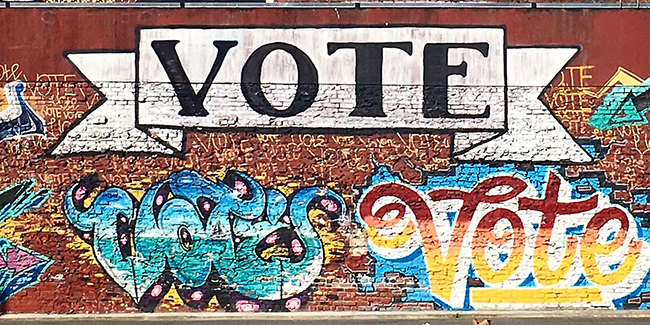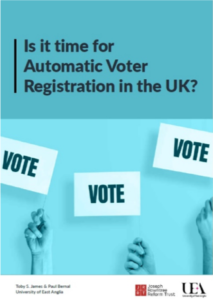It is time for automatic voter registration in the UK
Ahead of each UK election, there is a rush to get people registered to vote, and confusion about who is already registered. In a new report Toby James and Paul Bernal set out how to improve the system while protecting data privacy, through automatic or assisted voter registration, and so widen access to democratic participation.

Picture: Chris Christian / (CC BY-NC 2.0) licence
Electoral registers are a vital part of the machinery of democracy. They are the definitive record of who is able to vote in an election. Eligible or not, if your name is not on the register then you’re not voting. In the UK, they are also used to construct electoral boundaries and for other civic purposes – making them doubly important.
And yet the UK’s electoral registers have regularly made negative headlines. It is well known that millions of citizens are missing, and electoral officials are under severe pressure with a last-minute rush of applications close to deadline day before any election. There have therefore been calls for automatic voter registration (AVR) from parliamentary committees, campaigners, politicians and academics to address some of these problems. Cross-party parliamentary support for automatic voter registration has come from the Political and Constitutional Reform Committee in its 2014 report on Voter Engagement, and the All-Party Parliamentary Group on Democratic Participation’s report on the Missing Millions. The Electoral Commission called for automatic or direct voter registration processes in 2017, and there has been political party and civil society support from groups such as the Electoral Reform Society. Interest in automatic voter registration has no doubt been encouraged by debates in the US, where many states have introduced it in recent years.
Is it time to introduce automatic voter registration to the UK? And what actually is it? A new report commissioned by the Joseph Rowntree Reform Trust sets out arguments for and against. Debate about automatic voter registration has been made difficult by confusion about terminology with AVR used very loosely. There are also a range of philosophical and logistical questions that need to be thought through.

What is automatic voter registration?
Automatic voter registration is a broad principle and umbrella term that could in practice involve a range of different approaches. The report defines it as the direct enrolment of citizens onto the electoral register by public officials, without the need for pro-active action by citizens. This is in direct contrast with the current system used in the UK, where citizens are responsible for registering themselves ahead of the deadline for election day. The UK system is comparatively rare in democracies, with registration automatic in most countries.
Assisted voter registration is a half-way house which involves citizens being asked to register to vote when accessing other government services, for example when you renew your driving licence.
Options for automatic voter registration
There are a variety of different pathways to automatic voter registration. The first, and most direct, is the use of a new centralised civil population register, which is how it is implemented in many countries around the world. Broader concerns about civil liberties may make this approach unpopular, however.
Alternatives might include the expansion of other centralised governmental databases such as the Department of Work and Pensions’ Customer Information System to act as a single national electoral register. Currently electoral registers are maintained by local authorities, and localised registers could be maintained, but local officials could be given access to a broader set of national datasets which they could use to augment the register without the prior permission of citizens.
The report proposes an alternative route. Direct enrolment could be relatively easily achieved for specific groups – namely 16-year-olds when they are issued with their National Insurance Number. This would mean that citizens are systematically registered to vote when they are within the school system and it would provide an opportunity to provide comprehensive political and civic literacy. This would directly add 700,000 citizens to the roll each year with minimal administrative effort. At present young people are expected to register, public resources are spent encouraging them to do so, and they are threatened with fines if they don’t do as they are told. We could just save ourselves that battle.
At the same time, assisted voter registration could be introduced by prompting citizens to register to vote when accessing a range of other government services such as applying for a driving licence. Using Freedom of Information requests, we estimated that the number of times that citizens would therefore be prompted to register to vote:
- 6.5 million per year when applying for a passport
- 4 million people when they update their driving licence address with the DVLA
- 2 million people a year when applying for Universal Credit
- 2.5 million students through annual student enrolment
- 800,000 when they apply for child benefit for the first time
- 500,000 when they provide the Student Loans Company with a new address
- 450,000 when they apply for disability benefits
Data concerns
One area of the automatic voter registration debate that hasn’t been thought through in detail is privacy and the use of the electoral register. There is currently an open/edited register that citizens can opt out of. This can be purchased by anyone. It is currently used by companies to construct people databases where you can search for an individual’s address, likely age, length of residency, other household occupants, previous household occupants and neighbour’s details. This data is then combined with other sources such as the insolvency register; births, marriages and death records; land registry and business listings databases. You can therefore buy 27-page background reports on your person of interest. We think this register should be abolished. Any move to automatic or assisted voter registration should certainly ensure that citizens are not included on the open/edited register without an explicit action from them.
The main electoral register remains accessible to stakeholders such as elected representatives, political parties, government agencies and credit reference agencies. There is currently a provision to register entirely anonymously subject to strict criteria, meaning that no one except electoral officials can view your name and address. This is vitally important for citizens such as those who domestic abuse victims. Anonymous registration should be possible for a longer period (at least five years) and made easier to administer for a citizen in this situation. Automatic and assisted voter registration options are not therefore privacy threats if carefully managed. But there are privacy threats already there and these should be addressed.
The UK’s electoral register retains its Victorian origins – but has seen considerable modernisation over the past twenty years under successive governments. The report sets out 28 recommendations to modernise the UK’s electoral machinery for an inclusive 21st-century democracy. Moving to automatic and assisted voter registration is this next step.
The report, ‘Is it time for Automatic Voter Registration in the UK?’, can be downloaded here. This report was funded by the UK Democracy Fund. The UK Democracy Fund, a Joseph Rowntree Reform Trust Ltd initiative, funded the work reported in this publication. The material presented here represents the views of the author(s), not necessarily those of JRRT or other UK Democracy Fund contributors. This post represents the views of the authors and not those of Democratic Audit.
About the authors

Toby James is Professor of Politics and Public Policy at the University of East Anglia, UK. His most recent books are Comparative Electoral Management (Routledge, 2020) and Building Inclusive Elections (Routledge, 2020).

Paul Bernal is Associate Professor of IT, IP and Media Law at the University of East Anglia, UK. His most recent book is What do we know and what should we do about internet privacy (SAGE, 2020).





 Democratic Audit's core funding is provided by the Joseph Rowntree Charitable Trust. Additional funding is provided by the London School of Economics.
Democratic Audit's core funding is provided by the Joseph Rowntree Charitable Trust. Additional funding is provided by the London School of Economics.